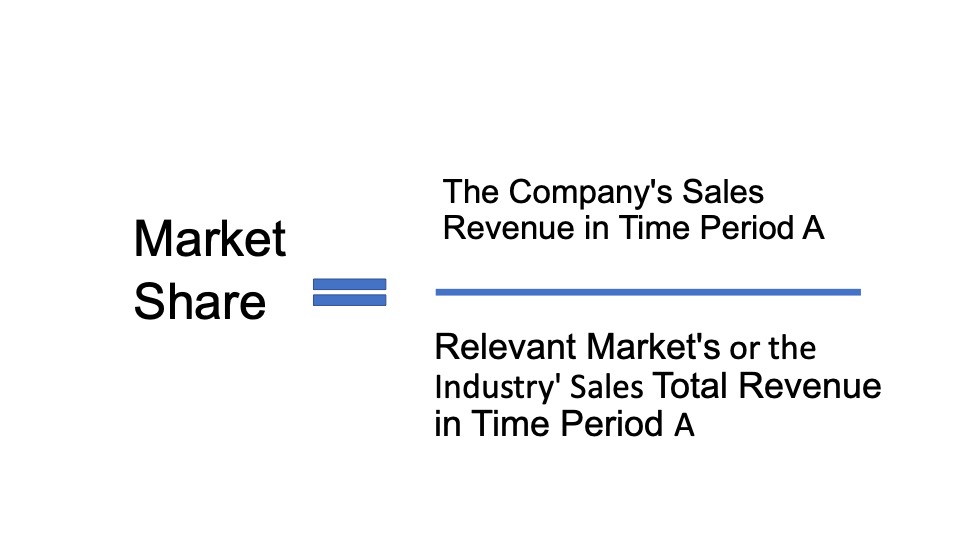What is Market Share? Benefits, Formula and Examples
When I was knee-high to a grasshopper, I often played a Supermarket Store game with my brother. We’d go to the kitchen, take out all the food in the pantry, and set up a supermarket store in our bedroom. I would typically sell “bowls.”
Imagine the total bowls that the whole “family market” sold was 10; and 4 out of those were bowls from my store, that would mean I had a 40% bowl Market share
That is market share.
You have definitely heard the term “Market share” if you have been in the industry or worked for a major corporation for some time. While even mid-to-low-level employees are familiar with the term and fully comprehend why Market share is critical for business growth, very few truly understand what Market share is. For the most part, Market share is the proportion of aggregate sales revenue generated by a company in an industry. Though Market share does not give the business owners a full picture of their company’s financial wellbeing, understanding their Market share percentage gives them an indication of the company’s size and success relative to their competition.
Below, let’s review Market share – what it is, how it is calculated, and why it is important.
What is Market share?
Every industry has a target group, and each company within an industry accounts for a percentage of that market. That is Market share. In other words, Market Share is the company’s total sales revenue in comparison to the industry.
Market share is often measured at the national level, such as a UK-only market share or Asian-only market share and at regional or niched levels.
Analysts can gather Market share statistics from numerous independent parties, such as trade associations and governmental agencies, and also from the company itself. Some fields, however, are tougher than others to calculate the Market share with precision.
Formula to calculate Market share
The easiest way of calculating a company’s Market share is to take that’s company number of revenue and then divide that number by that of the relevant industry.

A Company’s Market share = (The Company’s Sales Revenue in Time Period A) / (Relevant Market’s or the Industry’ Sales Total Revenue in Time Period A)
To calculate a company’s Market share, first determine a period you want to examine. It can be a fiscal quarter, year, or multiple years.
Next, calculate the company’s total sales revenues over that period. Then, find out the total sales of the company’s industry. Finally, divide the company’s total revenues by its industry’s total sales.
How to evaluate Market share
A small business owner might not be concerned with his Market share compared to national industry standards. However, if he wants to scale his business up, he may need to know who are making the most sales nationwide in his industry to analyze the similarities and differences between his and theirs.
For example: a car dealer would be less worried about the national market share standards than his regional market share. The dealership owner could perhaps draw a 30-mile radius on a map, with his area as the center point. He may look at how many car dealers who sell the same kinds of cars and the competitors’ cars are there in that specific area.

If that area produces 5,000 cars sold annually and the car dealer sells 1,000 among those, he has a 20 percent Market share in his 30-mile radius area. Those 1,000 vehicles sold may not be able to account for a mere percent of the nation’s Market share, that’s why he doesn’t need to worry about his National Market share. However, if that car dealer sees a 5% annual National Market share of another dealership in the same area, he will need to examine what makes that dealership so effective.
Define Market share Metrics
Not every company within an industry will have the same targeted market. Rolex, for example, will not waste money on capturing as many Market shares as Timex.

State Farm Insurance, for another example, seeks to finance experienced drivers to help reduce prices for their covered-by-insurance drivers, while Esurance accepts lower-risk drivers but charges more money.
Vitamix blenders pursue higher-end, nutrition-conscious eaters; in contrast, Kitchen Aid desires to be everyone’s blender.

See, Comparing the figures without comparing the industry segments is not giving a business the knowledge it wants.
Bear in mind that you shouldn’t use actual sales to assess its Market share. For instance, two companies A and B share the same target audience in the same location. On the one hand, company A’s products have higher prices, meaning that company A will theoretically have a larger Market share, even though they sell fewer units. Company B’s products, on the other hand, are priced lower, meaning that company B will have a lower Market share even though they sell more units.
For example, the overall market sells 5 million units annually, and company A sells 1.25 million, company B sells 2 million. Company A, therefore, has a 25% Market share while that of company B is 40%. This 25% - 40% gap may not worry company A if its products are priced higher and generating more profits. However, company A may want to try some strategies to win more Market share if it seeks to beat company B.
Some examples of Market share
Example Number 1:
Imagine a US-based Electronics Company named ABC has grossed $4 million in televisions. The total market grossed $100 million during the same time period. Therefore, the Market share for ABC Electronics is calculated as (4 / 100) 4%. This ABC company can use this number to assess its competitiveness in the respective market with its target audience.
This market share number can be separated into different categories to let a company know where it has a market advantage. Televisions, for example, may be further broken down into categories of television selling, such as LCD, LED, or 3D televisions. It may be separated into regional areas as well.
A company that has a 4-percent Market share on a national level can take pride in its number if it has one location in a tiny state. If a company has 50 branches in each of the 50 states, a Market share of 4 percent might not be a good number.
Example Number 2:
Total revenues for the pharmaceutical industry hit $1.3 trillion in the 2015 fiscal year. The sales of pharmaceutical firm A were $47.4 billion over the same period.
The pharmaceutical firm A’s Market share is estimated as follows:
Market share = 48 billion dollars / 1.3 trillion dollars = 3.7 percent.
Given that pharmaceutical firms have to be subjected to tremendous research and development, it takes longer for a medicine product to be approved in the United States, therefore grossing nearly $50 billion in revenue is a huge accomplishment.
To acquire more Market share, the pharmaceutical firm X chooses to sell different products at various price ranges to satisfy more customers. The firm also chooses to focus on the treatment of coronary disorders and will approach customers belonging to test groups. This approach of coming up with more products would help the company grow its customer base and boost its overall revenue.
Bear in mind that a profitable firm does not always have a significant Market share number in the industry. Income and Market share are not necessarily related.
Example Number 3:
If a company sold $200 million in farm machinery domestically last year, while the overall sales of farm machinery sold in the U.S. were $400 million, the U.S. Market share of the company for tractors will be 200/400 = 50 percent.
Example number 4:
All multinational firms evaluate their success based on their Market share within specific markets. For example, China has been an important market for Apple as it is one of the fast-growing markets for many products.
Apple uses its Market share statistics in China as a key performance indicator for the development of its business. Despite the overall Chinese smartphone industry rising by 9 percent in 2016, Apple’s Market share in China’s smartphone market declined from 13.6 percent at the end of 2015 to 9.6 percent in 2016. Apple’s market share dropped in China in that year because its new iPhones struggled to meet the needs of the Chinese, and also because its rivals OPPO and VIVO launched a series of mid-range smartphones, which better catered to the Chinese Market.
The importance of Market share
Changes in Market share, on the one hand, have little effect on firms in developing industries. In these markets, the aggregate pie is constantly getting bigger, so firms will still gain profits even though they lose Market share. The production of firms in this situation is more influenced by revenue growth and margins than other factors.
Market share changes, on the other hand, have a more significant effect on the output of firms in developed or cyclical markets with slower growth.
Cyclical market is an industry sector that is vulnerable to the business cycle, profits typically are higher in times of prosperity and expansion and are lower in periods of economic crisis and recession.

Competition for Market share in cyclical industries is harsh. Economic factors play a more significant role in the variance of selling, profits, and margins more than other factors. Margins tend to be low, and operations tend to run at optimum productivity because of intense competitions.
Companies in these industries may need to spend heavily on promotion campaigns or even on product or service at a meager and not profitable price in order to win new customers or to sell bundles to those customers (loss leaders) - because sales for their company means a loss for others
Worse, companies in cyclical industries may resort to spending money on coercing competitors to give up or claim bankruptcy. They try to boost rates until they win higher Market share, and force their rivals to step down. This technique can succeed, or it can end up backfiring. However, this is why a few major companies control specific markets, such as discount wholesale retail with stores like Sam’s Club, BJ’s Wholesale Club, and Costco.
Key takeaway: With industries that are on the growth, companies can still earn huge profits even if they are losing Market share. In contrast, with discretionary income sectors, such as tourism or non-essential products like entertainment and recreation, market share can have a more significant effect on the financial output. Depending on the time of year, revenue and margins will vary, meaning that competition is intense at all times.
Companies may resort to risky strategies if they are facing high competitions. They, for example, may be willing to temporarily lose revenue to drive competitors out of business and win more Market share. They will raise the products’ prices once they have more Market share to make up for the loss.
Benefits of Market share
Although Market share does not provide a company with clear picture regarding its financial performance, it gives key indicators into the company’s profits, growth, and net income. This is linked to economies of scale. The bigger the company, the more cost-efficient it can accommodate higher numbers of customers.
Companies with a higher Market share can bulk order products or supplies for a discounted price. Therefore, even at the same price range as its rivals, a bigger business with a greater Market share will still have a higher net profit, rendering it a healthier business altogether. Bulk ordering also allows the company to offer more discounts or promotions; hence customers from its rivals will be more likely to switch brands, increasing Market share even higher.
All in all, Market share appears to be a key driver within a company that has a compounding impact. The bigger the company, the easier it can offer products to customers and capture more Market share. As that company wins more Market share, this loop begins again.

It is feasible to have too much Market share. Of course, big corporations like Walmart would be more than happy to dominate every market, from toys to clothes, with no one being able to compete with it. Yet government antitrust regulations are in force, prohibiting corporations from being too large, and ruling the whole market. Without having to compete, big corporations would have the freedom to set the price to whatever they see fit, therefore, the products would be more expensive than when competition exists.
Other industries such as banks, insurances, and finance-related institutions would not want to have a 100 percent Market share because 100 percent Market share will translate to 100 percent of the risk. These firms became successful by capturing the right amount of Market share to ensure that if a significant incident happens, they will not be over-extended with 100 percent market liability.
Key Takeaway: Market share measurement helps firms to understand how competitive they are in their field. Besides, the more Market shares a business has, the more creative, desirable, and commercially viable they generally are. In sectors that are based on discretionary profits, Market share is more significant. Market share doesn’t always have a major effect in markets that are continuously rising. However, it’s important to remember that a company can have too much Market share — also known as a monopoly.
How to increase your company Market share
As I have said above, Market share appears to be a key driver within a company that has a compounding impact. The bigger the company, the easier it can offer products to customers and capture more Market share. As that company wins more Market share, this loop begins again.
But how can we win more Market share?
1. Offering lower prices
Offering low pricing is a perfect way to compete in the industry. There is close-to-zero consequence when it comes to Market share expanding as ordinary buyers mostly search for lower-cost goods.
It is also important to remember that the “cheap” option is not the appropriate step for every brand, especially high-end ones. Imagine a world where Apple offers brand-new iPhones, but instead of $1100 like the iPhone 12, they only cost $100. The company’s Market share figure would rocket, but at the expense of losing its luxurious branding.
2. Innovate new products and features
Companies that are continually developing and introducing new technology to the world often capture more Market share.
When a company launches a new invention to the market its competitors have yet to deliver, people are more likely to choose to purchase the technology from that company, even though they might be loyal customers to a competitor in the past. After such companies have taken in new customers, they will work on customer loyalty and build a close-knit relationship with their customers. Many of those consumers would then become repeat customers, which adds to the brand’s Market share and lowers the Market share of the business they moved from.
If a business dominates the market, which means that a business has the highest Market share, complacency will become a concern. Companies looking for increases in Market share aim to invent goods to offer something new to customers.
At the end of the day, innovation is what makes Apple become the world’s foremost maker of smartphones and tablet computers. They continue to evolve and demand high prices for their innovations while retaining Market share at the top of the list.

Or look at Vera Bradley bags and luggage for another example. This company has been a common option for female baby boomers since the 1980s. As the company wanted to broaden its target base and cater to younger women, it tapped into social networks to gain insights into the target market.
The company managed to find a pattern of millennial concerns about the deficiencies of battery life on smartphones and the discomfort of bulky battery cases. So, Vera Bradley developed a backpack with a built-in smartphone charger. This backpack invention helps diversify its product’s catalog and attract a new demographic without making changes that could alienate its existing, long-time clients.
3. Attract new demographic
If you have managed to bring to the table something new, your marketing team can then launch some marketing campaigns for that, meaning figuring out a way tap into a larger market chunk, running promotional offers, special offers, or sales to attract new customers.
Vitamix, for example, run roadshows at Costco sites, with special deals during the show. In the roadshow, they introduce to consumers many new product features by a trained demo host and allow the audience to buy the product at a lower price, and often with free accessories tossed in to sweeten the bargain. This strategy helps maintain the products’ price integrity, build the brand identity, and offer a discounted price to get more Market share.
4. Work on your customers’ satisfaction
Working on your customers’ satisfaction is one of the finest ways to increase your Market share. By improving customer relationships, businesses can attract new buyers using word-of-mouth, preserving their Market share by stopping current customers from leaving the company even when a rival throws out a trendy new deal.
You, as a company owner or marketing executives, should establish loyalty among your current customer base, so they keep returning, spend more money on your business and share great reviews with their social circles, empowering them also to become customers. Winning customers by word-of-mouth helps a company gain more revenues without spending a dollar on marketing.

Compared to the complex branding and promotion strategies that other corporations employ, focusing on customers’ retention is an economical way to gain Market share. For example, let’s look at some high-caliber investment management companies like Waddell and Reed. To grow the company’s Market share, these companies focus more on relationships and recommendations. This approach builds a customer base that is more committed than non-personal marketing tactics and also more affordable than doing ads on TV, online, and in financial newspapers.
So, how can you retain your customers?
Customers become clients when they are aware that the company and its staff respect and care about them. Employee training in communication and customer support skills is as vital as sales skills. Sending thank you to consumers and holiday greetings such as birthday cards are effectively used by service providers.
Another approach is to deliver services such as loyalty and incentive programs to current consumers. You may provide exclusive discount packages for current consumers or give discounts to your customers for being loyal over a fixed minimum amount of time. You may provide your customers a free cup of coffee when they have ordered 10 of it, or give out a 50% coupon when a customer brings along a new one, etc. These tactics help you offer your loyal clients something different from what a new customer would get.
But these tactics are just … tactics, and they are ubiquitous these days
Let’s go back a bit.
You need to connect with your clients to build the relationship, establish partnerships and emotions with which no price change, publicity strategy, or discount can compare. Relationship marketing helps you reach into the customers’ mind (and heart) by establishing: an intimate connection, a purpose-driven connection, and brand community.
4.1. Establishing an intimate connection between you and your customers
As you hear of customer engagement and evangelism, do the first brands that spring to your mind are Apple, Tesla, and Nike? It is not an exaggeration to say that these businesses have built a relationship so strong with their clients that their customers would fiercely protect it if anyone were to speak poorly or attack them.
You need to Build faith, exhibit personality, inspire loyalty, and provide a better customer experience.
-
Build faith: Faith plays an integral part in every relationship, so make sure that you deliver on your word at every step of your customers. Don’t just say you are this and that to customers; demonstrate to them you are!
-
Exhibit personality: It’s time to tear down the firewall between you and your customers and let them know who you are, who the people behind your brand are. You may do so by uploading your workers’ pictures on social media or sharing stories about how you support the local environment in your email marketing. Take the audience with you every step of the way and encourage them to share their images or stories. A great way to create a stronger bond with the customers is to involve them in the discussion.
-
Inspire confidence. Are two individuals sign up for a trial of your service, are having the same experience? They’re supposed to. Does the experience vary depending on where a customer is? It should not. How about the contact strategy? It should also be consistent. Maintaining a cohesive identity in your industry inspires customers’ confidence, whether in your promotional ads, sales pitches, or on the website.
-
Provide a brilliant consumer service: With the advent of technology, what used to be “novel” is becoming “common.” A decent customer service isn’t enough anymore. You need to have an unforgettable, enjoyable, and emotional customer experience today.
4.2. Establish a meaningful purpose to be in business
Providing value will only help strengthen the bond between you and your customers, whether in the form of content, tech functionality, or customer support.
But there is a different way to tap your consumers’ souls, and that is by having a purpose: An aim outside sales, gains, and the distribution of dividends.

Customers today tend to do business with organizations that advocate for something good, whether it’s fundraising, encouraging justice and battling inequality, or solving environmental concerns.
4.3. Take care of your community
- Bring together your community.
- Listen to every word from your community:
- Encourage your loyal audience to tell the world about your service through awareness campaigns
- Praise your customers
5. Invest in employees
Businesses with the largest Market share virtually always have the most qualified and committed workers. Bringing the best staff on board decreases turnover and preparation costs and helps firms dedicate more money to concentrate on their competitive advantages. One common approach to recruiting the best talent is to offer fair pay and benefits. However, employees these days are looking beyond tangible advantages, such as flexible hours and casual work conditions.
6. Establish Brand Awareness
Overall branding and nationwide marketing are set objectives for national brands such as Geiko, JP Morgan Chase, and Staples. You can’t even watch a sporting event without bumping into one of these companies or a related one behind center field. They air ads on all channels, have billboards everywhere, and populate the market so that anytime people need a service, they will think of them before any of their rivals.

7. Acquire your competitors
Acquiring a competitor would be another strategy to win Market share.
Acquisitions can serve two purposes. First, it taps into the newly purchased company’s current customer base, and it cuts the number of businesses competing over a piece of the same pie by one. CEO, executives, managers, whether in charge of a small company or big enterprise, often have their eye out for a successful acquisition contract while their businesses are on the growth
Second, if Company A had a Market share of 10%, and Company B had 15%, the newly combined company would automatically have a Market share of 25%. Not only would it raise its Market share, acquiring rival competitors would benefit from economies of scale (the bigger the company, the more cost-efficient it can accommodate higher numbers of customers). These perks make it easier to win new buyers, thus theoretically grow even more Market share.
Final Thoughts
Market share is the percentage of an industry, or a specific market’s total sales revenue that a particular company earns over a specified period of time. To calculate the Market share, first determine a time period, then take the company’s sales over that period and divide it by the relevant industry’s total sales over the same period.
People can use this metric to have a general picture of a company’s size in relation to its industry and its competitors.
Market share changes have a greater impact on the performance of businesses in mature or cyclical industries with low growth. Changes in Market share, by contrast, have less effect on businesses in growing industries.
Market share appears to be a key driver within a company that has a compounding impact. The bigger the company, the easier it can offer products to customers and capture more Market share. As that company wins more Market share, this loop begins again.
New Posts






